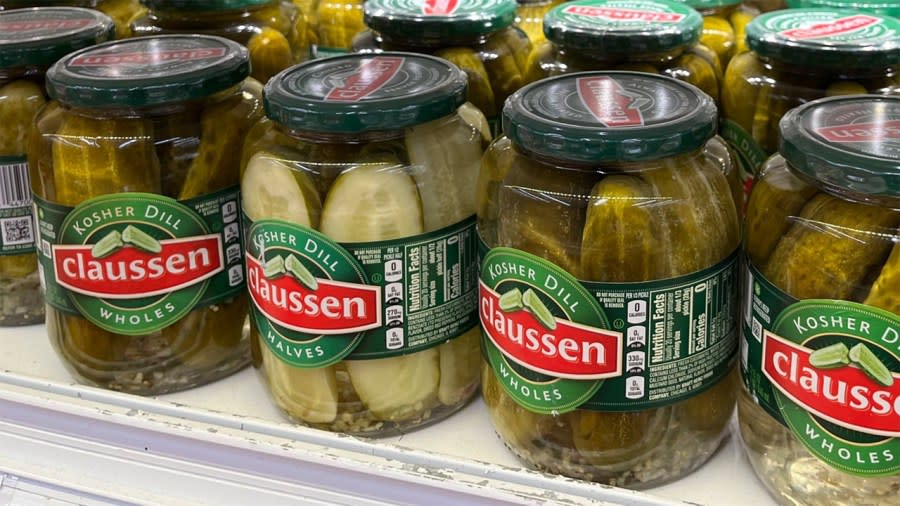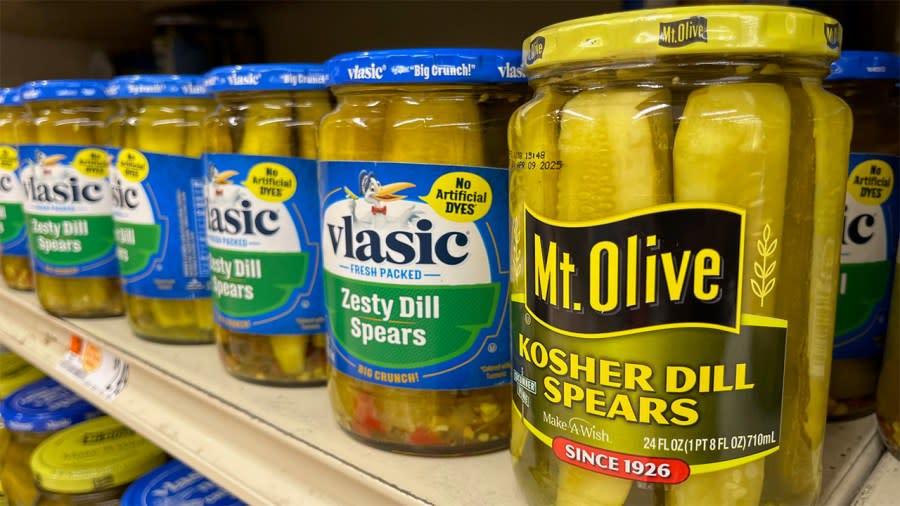(NEXSTAR) – Quick, run over to your fridge and grab a jar of pickles. Notice something missing from the label?
If you’re holding a jar of Vlasic, Claussen or Mt. Olive pickles, chances are it’s missing the word “pickle” on the front.
“I don’t think it’s a coincidence; there has to be some reason for it,” theorized TikTok user Jesse Banwell, who brought the issue to light this week a now-viral video. “Maybe it’s some legal thing. I don’t really know.”
Banwell, a science teacher from Santa Cruz County, California, isn’t the first to notice the omission. A couple of Reddit posts from both 2017 and 2019 had previously pointed out the lack of any “pickle”-language on the jars of different brands. And an earlier TikTok video from 2019 highlighted the same point — complete with a hashtag reading #picklesdontexist — in response to a third brand’s pickle jar.
View the latest headlines from Kansas City, Missouri, and Kansas at fox4kc.com
So what do the labels say, exactly? Vlasic, Claussen and Mt. Olive often describe their products as “dills,” “spears” or “chips,” and sometimes use the terms “wholes” or “halves” (instead of “pickle wholes” or “pickle halves”).
“They’re identifying them by their shapes,” said Banwell, speaking with Nexstar this week. “I just think that’s so weird.”
There are some notable exceptions, of course. Unlike most of Vlasic’s other pickled cucumber varieties, the company produces a line of “Purely Pickles” products touted as has having no artificial flavors, preservatives or colors — and the words “Purely Pickles” is clearly visible on the label. Mt. OIive, too, produces a similar line referred to as “Simply Pickles.”
And the word “pickle” isn’t entirely absent from most labels — though it’s not visible in any context a consumer might expect: Mt. Olive and Claussen include the word “pickle” within the URLs for their official websites (mtolivepickles.com and pickles.com, respectively), and those URLs can be found in very small print on the lid or label. (Mt. Olive’s business name, “Mt. Olive Pickle Company,” can also be found in small print on the side of the label.) Vlasic also sometimes uses the word “pickle” on the lid of its jars, in the context of the brand’s catchphrase. (“That’s one crunchy pickle!” some jars say, though others read “That’s the tastiest crunch I’ve ever heard!” A representative for the brand told Nexstar the lids are interchangeable, and not “product-specific.”)
What do the pickle companies say?
Despite avoiding the word “pickle” on most of their labels, Vlasic, Claussen and Mt. Olive all use the term on their websites, in advertisem*nts, and in the product descriptions of their pickle varieties.
When asked why the word isn’t on the front of the jars, all three companies provided nearly the same answer: They feel the word “pickle” isn’t necessary on pickles packaged in clear glass containers.
“When pickle lovers see the clear Vlasic jar, they know they’re getting a great tasting pickle every time,” wrote Carolyn Goldberger, the brand manager at Vlasic, in a statement shared with Nexstar. “We use the limited label space to clearly communicate the form and flavor inside each jar. That way consumers can easily find their favorite Vlasic. But no matter the style, it’s definitely a pickle!”
Mt. Olive similarly claimed that its packaging focuses on the variety rather than the product, to make it “easier for consumers to spot the type of pickle they are looking for on the shelf, without having a busy or distracting label.”
A representative for Kraft Heinz (the owner of the Claussen brand) went a step further, attesting in its statement that Claussen’s pickles “meet all regulations required of pickles.” But Claussen, too, “prefer[s] to showcase our varying styles and varieties on-pack,” the Kraft Heinz spokesperson said.
“I really don’t buy that as the reason,” Banwell told Nexstar. “I’ve been looking at other products at see-through packaging, you know, hamburger buns, things like that. I have yet to find another clear package that does not say what it is on the front.”
“I was thinking about Kleenex, where even the name brand transcends the product,” Banwell added. “If you say you need a Kleenex, everyone knows you want a tissue. But [the packages] all still say tissues on the product.”
Online theories
Banwell’s viral post has generated a significant discussion on TikTok, with users theorizing why a pickle brand might choose to omit the name of its product on the product’s own label.
Some claimed it was because “pickle” refers to the process of preserving the cucumber, and not the item itself, which is more accurately described as a pickled cucumber. But that wouldn’t explain why other brands — Boar’s Head, Grillo’s, McClure’s — prominently use the term “pickle” (and not pickled cucumber) on their labels.
Others theorized that the pickles sold by certain brands don’t fit the legal definition of a pickle, or that they’re somehow produced using a process other than traditional pickling.
In response to the latter concern, TikTok user and musician Sami Hunter researched both the USDA and FDA definitions of “pickle,” determining that the latter categorizes pickles under “acidified foods.” These acidified foods, according to the FDA, must maintain a “finished equilibrium pH of 4.6 or below.”
Hunter then tested the acidity of eight different varieties of pickles, including Vlasic, Claussen and Mt. Olive, along with multiple brands that advertised themselves as “pickles” on the label. All were within the range of a “pickle” as far as the FDA defines it, according to Hunter’s at-home pH testing kit.
“It was a whole lot of fun to research what makes a pickle a pickle (at least in the eyes of the government),” said Hunter, who told Nexstar this week that she still can’t quite make sense of the labeling issue. “At the end of the day, though, fermented or vinegared, whether vegetables, meat, or eggs, I still love all the pickles.”
FDA, USDA definitions of ‘pickle’
Pickles, like any other mass-produced and marketed foodstuff, are subject to the regulations of the FDA and USDA. To be called a “pickle” or a “pickled” food, the item must be a low-acid food to which acid is applied, and ultimately have a “water activity (aw) greater than 0.85 and have a finished equilibrium pH of 4.6 or below,” according to the FDA.
“These foods may be called, or may purport to be, ‘pickles’ or ‘pickled ______,’” the agency writes.
Will Kansas City hit 100 degrees this year? There’s a chance this weekend
The FDA also stipulates that the food’s common name, or its “statement of identity,” should be placed prominently on the label, also known as the product display panel (PDP). (“The common or usual name must be used for a food if it has one,” the FDA writes.)
The exception are “fanciful” names which the public has grown used to — the USDA provides examples including “breakfast links” to describe sausage links, or buttery “spreads” to describe spreadable emulsions or butter substitutes.
Could it be that terms like “kosher dill” or “bread & butter chips” are fanciful enough companies like Vlasic, Claussen and Mt. Olive are exempt from writing “pickles” on the label? A representative for the FDA did not provide Nexstar with an answer when asked earlier this week.
In any case, many consumers on social media find it odd that a pickling company would omit “pickles” from its pickle jars. Some competitors seem to feel the same way, too.
“It’s funny — I’ve noticed it on a few brands but didn’t pay much attention to it,” Eddie Andre, the head of branding for Grillo’s, told Nexstar. “For Grillo’s, using the word pickle has always been in our vocabulary. … Calling out “pickle” was what we did to tell people what we were selling and that’s no different in our jars.”
All of these pickle brands, meanwhile, do appear to abide by another FDA requirement, which necessitates the words “whole,” “halved” or “sliced” to describe products that come in “different optional forms.”
Still a pickle
Despite the online controversy generated by Banwell’s TikTok post, major pickle manufacturers have given consumers no reason to believe their products somehow aren’t real pickles. They are, however, happy to let us believe they just don’t care whether their pickle products are called “pickles.”
“They basically say they choose not to label them as pickles,” Banwell remarked on the findings. “Which is really interesting … and just doesn’t sound right.”

